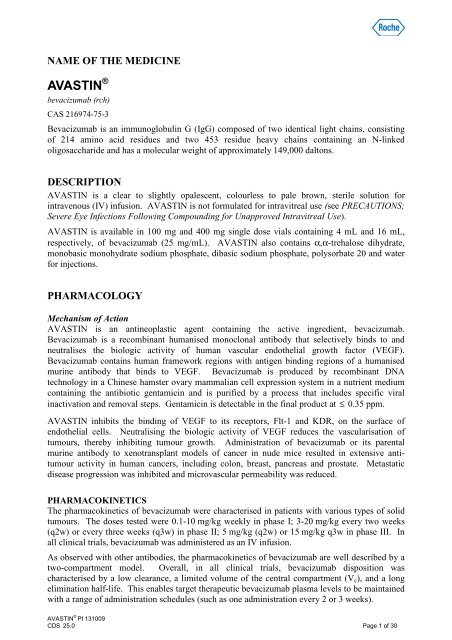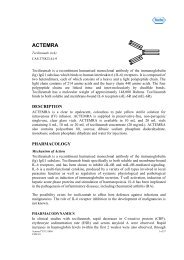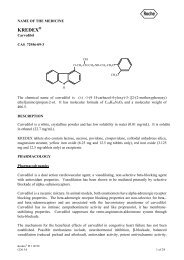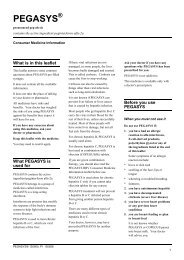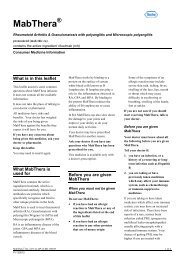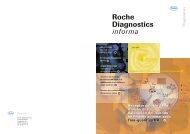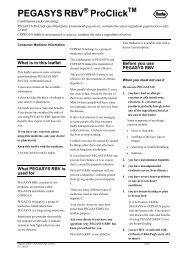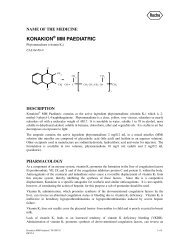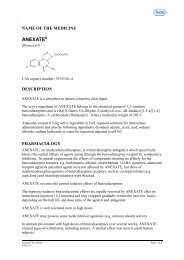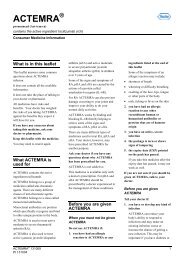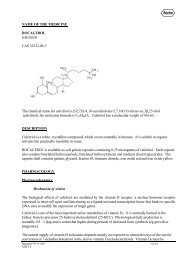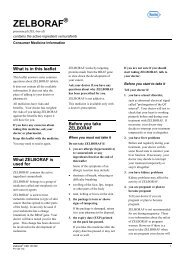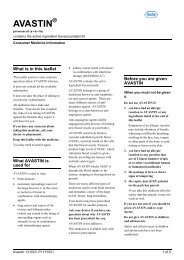Avastin (bevacizumab) Product Information (PI) - Roche Australia
Avastin (bevacizumab) Product Information (PI) - Roche Australia
Avastin (bevacizumab) Product Information (PI) - Roche Australia
Create successful ePaper yourself
Turn your PDF publications into a flip-book with our unique Google optimized e-Paper software.
NAME OF THE MEDICINE<br />
AVASTIN ®<br />
<strong>bevacizumab</strong> (rch)<br />
CAS 216974-75-3<br />
Bevacizumab is an immunoglobulin G (IgG) composed of two identical light chains, consisting<br />
of 214 amino acid residues and two 453 residue heavy chains containing an N-linked<br />
oligosaccharide and has a molecular weight of approximately 149,000 daltons.<br />
DESCRIPTION<br />
AVASTIN is a clear to slightly opalescent, colourless to pale brown, sterile solution for<br />
intravenous (IV) infusion. AVASTIN is not formulated for intravitreal use (see PRECAUTIONS;<br />
Severe Eye Infections Following Compounding for Unapproved Intravitreal Use).<br />
AVASTIN is available in 100 mg and 400 mg single dose vials containing 4 mL and 16 mL,<br />
respectively, of <strong>bevacizumab</strong> (25 mg/mL). AVASTIN also contains a,a-trehalose dihydrate,<br />
monobasic monohydrate sodium phosphate, dibasic sodium phosphate, polysorbate 20 and water<br />
for injections.<br />
PHARMACOLOGY<br />
Mechanism of Action<br />
AVASTIN is an antineoplastic agent containing the active ingredient, <strong>bevacizumab</strong>.<br />
Bevacizumab is a recombinant humanised monoclonal antibody that selectively binds to and<br />
neutralises the biologic activity of human vascular endothelial growth factor (VEGF).<br />
Bevacizumab contains human framework regions with antigen binding regions of a humanised<br />
murine antibody that binds to VEGF. Bevacizumab is produced by recombinant DNA<br />
technology in a Chinese hamster ovary mammalian cell expression system in a nutrient medium<br />
containing the antibiotic gentamicin and is purified by a process that includes specific viral<br />
inactivation and removal steps. Gentamicin is detectable in the final product at £ 0.35 ppm.<br />
AVASTIN inhibits the binding of VEGF to its receptors, Flt-1 and KDR, on the surface of<br />
endothelial cells. Neutralising the biologic activity of VEGF reduces the vascularisation of<br />
tumours, thereby inhibiting tumour growth. Administration of <strong>bevacizumab</strong> or its parental<br />
murine antibody to xenotransplant models of cancer in nude mice resulted in extensive antitumour<br />
activity in human cancers, including colon, breast, pancreas and prostate. Metastatic<br />
disease progression was inhibited and microvascular permeability was reduced.<br />
PHARMACOKINETICS<br />
The pharmacokinetics of <strong>bevacizumab</strong> were characterised in patients with various types of solid<br />
tumours. The doses tested were 0.1-10 mg/kg weekly in phase I; 3-20 mg/kg every two weeks<br />
(q2w) or every three weeks (q3w) in phase II; 5 mg/kg (q2w) or 15 mg/kg q3w in phase III. In<br />
all clinical trials, <strong>bevacizumab</strong> was administered as an IV infusion.<br />
As observed with other antibodies, the pharmacokinetics of <strong>bevacizumab</strong> are well described by a<br />
two-compartment model. Overall, in all clinical trials, <strong>bevacizumab</strong> disposition was<br />
characterised by a low clearance, a limited volume of the central compartment (V c ), and a long<br />
elimination half-life. This enables target therapeutic <strong>bevacizumab</strong> plasma levels to be maintained<br />
with a range of administration schedules (such as one administration every 2 or 3 weeks).<br />
AVASTIN ® <strong>PI</strong> 131009<br />
CDS 25.0 Page 1 of 30
In the population pharmacokinetics analysis there was no significant difference in the<br />
pharmacokinetics of <strong>bevacizumab</strong> in relation to age (no correlation between <strong>bevacizumab</strong><br />
clearance and patient age [the median age was 59 years with 5 th and 95 th percentiles of 37 and 76<br />
years]).<br />
Low albumin and high tumour burden are generally indicative of disease severity. Bevacizumab<br />
clearance was approximately 30% faster in patients with low levels of serum albumin and 7%<br />
faster in subjects with higher tumour burden when compared with the typical patient with median<br />
values of albumin and tumour burden.<br />
Absorption and Bioavailability<br />
Not applicable.<br />
Distribution<br />
The typical value for central volume (V c ) was 2.73 L and 3.28 L for female and male patients,<br />
respectively, which is in the range that has been described for IgGs and other monoclonal<br />
antibodies. After correcting for body weight, male patients had a larger V c (+20%) than female<br />
patients.<br />
Metabolism<br />
Assessment of <strong>bevacizumab</strong> metabolism in rabbits following a single IV dose of 125 I-<br />
<strong>bevacizumab</strong> suggested that its metabolic profile was similar to that expected for a native IgG<br />
molecule which does not bind VEGF.<br />
Elimination<br />
The pharmacokinetics of <strong>bevacizumab</strong> are linear at doses ranging from 1.5 to 10 mg/kg/wk.<br />
The value for clearance is, on average, equal to 0.188 and 0.220 L/day for female and male<br />
patients, respectively. After correcting for body weight, male patients had a higher <strong>bevacizumab</strong><br />
clearance (+17%) than females. According to the two-compartmental model, the elimination<br />
half-life is 18 days for a typical female patient and 20 days for a typical male patient.<br />
Pharmacokinetics in Special Populations<br />
The population pharmacokinetics of <strong>bevacizumab</strong> were analysed to evaluate the effects of<br />
demographic characteristics. The results showed no significant difference in the<br />
pharmacokinetics of <strong>bevacizumab</strong> in relation to age.<br />
Children and adolescents: The pharmacokinetics of <strong>bevacizumab</strong> have been studied in a limited<br />
number of paediatric patients. The resulting pharmacokinetic data suggest that the volume of<br />
distribution and clearance of <strong>bevacizumab</strong> were comparable to that in adults with solid tumours.<br />
Renal impairment: No studies have been conducted to investigate the pharmacokinetics of<br />
<strong>bevacizumab</strong> in renally impaired patients since the kidneys are not a major organ for<br />
<strong>bevacizumab</strong> metabolism or excretion.<br />
Hepatic impairment: No studies have been conducted to investigate the pharmacokinetics of<br />
<strong>bevacizumab</strong> in patients with hepatic impairment since the liver is not a major organ for<br />
<strong>bevacizumab</strong> metabolism or excretion.<br />
Patients with ascites: No studies have examined the effect of ascites on the pharmacokinetic<br />
parameters of <strong>bevacizumab</strong>.<br />
AVASTIN ® <strong>PI</strong> 131009<br />
CDS 25.0 Page 2 of 30
CLINICAL TRIALS<br />
Metastatic Colorectal Cancer<br />
The safety and efficacy of AVASTIN in metastatic colorectal cancer were studied in two<br />
randomised, active-controlled clinical trials. AVASTIN was combined with two chemotherapy<br />
regimens:<br />
• AVF2107g: A weekly schedule of irinotecan/bolus fluorouracil/leucovorin † (IFL) for a total<br />
of 4 weeks of each 6 week cycle<br />
• AVF0780g: In combination with bolus fluorouracil/leucovorin † (FU/LV) for a total of 6<br />
weeks of each 8 week cycle (Roswell Park regimen)<br />
Two additional studies were conducted in first (NO16966) and second line (E3200) treatment of<br />
metastatic carcinoma of the colon or rectum, with AVASTIN administered in the following<br />
dosing regimens, in combination with FOLFOX-4 (FU/LV/Oxaliplatin) and XELOX<br />
(Capecitabine/Oxaliplatin):<br />
• NO16966: AVASTIN 7.5 mg/kg of body weight every 3 weeks in combination with oral<br />
capecitabine and IV oxaliplatin (XELOX) or AVASTIN 5 mg/kg every 2 weeks in<br />
combination with leucovorin † plus fluorouracil bolus, followed by fluorouracil infusion,<br />
with IV oxaliplatin (FOLFOX-4).<br />
• E3200: AVASTIN 10 mg/kg of body weight every 2 weeks in combination with<br />
leucovorin † and fluorouracil bolus, followed by fluorouracil infusion, with IV oxaliplatin<br />
(FOLFOX-4).<br />
† The <strong>Australia</strong>n Approved Name for leucovorin is folinic acid<br />
Study AVF2107g<br />
This was a phase III randomised, double-blind, active-controlled clinical trial evaluating<br />
AVASTIN in combination with IFL as first-line treatment for metastatic colorectal cancer.<br />
Eight hundred and thirteen patients were randomised to receive IFL plus placebo (Arm 1) or IFL<br />
plus AVASTIN (Arm 2), see Table 1. A third group of 110 patients received FU/LV plus<br />
AVASTIN (Arm 3). Enrolment in Arm 3 was discontinued, as pre-specified, once safety of<br />
AVASTIN with the IFL regimen was established and considered acceptable. The median age of<br />
patients was 60 years (range 21-88), 60% were male.<br />
Table 1: Treatment regimens in study AVF2107g<br />
Treatment Starting Dose Schedule<br />
Arm 1 Irinotecan 125 mg/m 2 IV Given once weekly for 4 weeks every 6 weeks<br />
Fluorouracil 500 mg/m 2 IV<br />
Folinic acid 20 mg/m 2 IV<br />
Placebo IV Every 2 weeks<br />
Arm 2 Irinotecan 125 mg/m 2 IV Given once weekly for 4 weeks every 6 weeks<br />
Fluorouracil 500 mg/m 2 IV<br />
Folinic acid 20 mg/m 2 IV<br />
AVASTIN 5 mg/kg IV Every 2 weeks<br />
Arm 3 Fluorouracil 500 mg/m 2 IV Given once weekly for 6 weeks every 8 weeks<br />
Folinic acid 500 mg/m 2 IV<br />
AVASTIN 5 mg/kg IV Every 2 weeks<br />
Fluorouracil: IV bolus injection immediately after folinic acid<br />
Folinic acid: IV bolus injection (over 1- 2 minutes) immediately after each irinotecan dose<br />
AVASTIN ® <strong>PI</strong> 131009<br />
CDS 25.0 Page 3 of 30
The primary efficacy endpoint of the trial was overall survival. At the time of data cut-off, 399<br />
deaths had occurred in patients randomised to Arm 1 (n = 225) and Arm 2 (n = 174). The<br />
addition of AVASTIN to IFL resulted in a statistically significant increase in overall survival.<br />
Results are presented in Table 2 and Figure 1. The clinical benefit of AVASTIN, as measured by<br />
survival, progression-free survival and objective response, was seen in all pre-specified patient<br />
subgroups, see Figure 2.<br />
Table 2: Efficacy results for study AVF2107g<br />
Arm 1<br />
IFL plus placebo<br />
(n = 411)<br />
Arm 2<br />
IFL plus AVASTIN a<br />
(n = 402)<br />
Arm 3<br />
FU/LV plus AVASTIN a<br />
(n = 110 b )<br />
Overall Survival<br />
Median (months) 15.6 20.3 18.3<br />
Hazard ratio c (95% CI) 0.660 (0.54, 0.81)<br />
p-value (log rank) 0.00004 -<br />
Progression-Free Survival<br />
Median (months) 6.2 10.6 8.8<br />
Hazard ratio (95% CI) 0.54 (0.45, 0.66)<br />
p-value (log rank)
Figure 2: Duration of survival by baseline risk factor in study AVF2107g<br />
CI= interval; IFL= irinotecan/fluorouracil/ leucovorin (folinic acid);.<br />
Hazard ratio
IFL = irinotecan/ fluorouracil/ leucovorin (folinic acid); AVF = AVASTIN<br />
Study AVF0780g<br />
This was a phase II randomised, active-controlled, open-labelled clinical trial investigating<br />
AVASTIN in combination with FU/LV as first-line treatment of metastatic colorectal cancer.<br />
Seventy one patients were randomised to receive bolus FU/LV or FU/LV plus AVASTIN<br />
(5 mg/kg every 2 weeks). A third group of 33 patients received bolus FU/LV plus AVASTIN<br />
(10 mg/kg every 2 weeks). Patients were treated until disease progression. The median age was<br />
64 years (range 23-85), 57% were male. The primary efficacy endpoints of the trial were<br />
objective response rate and progression-free survival. The addition of AVASTIN (5 mg/kg every<br />
two weeks) to FU/LV resulted in higher objective response rates, longer progression-free survival<br />
and a trend in longer survival, compared with FU/LV chemotherapy alone, see Table 3. This<br />
efficacy data is consistent with the results from study AVF2107g.<br />
Table 3: Efficacy results for study AVF0780g<br />
FU/LV<br />
(n = 36)<br />
FU/LV plus<br />
AVASTIN a<br />
(n = 35)<br />
FU/LV plus<br />
AVASTIN b<br />
(n = 33)<br />
Overall Survival<br />
Median (months) 13.6 17.7 15.2<br />
Hazard ratio c - 0.52 1.01<br />
p-value (log-rank) - 0.073 0.978<br />
Progression-Free Survival<br />
Median (months) 5.2 9.0 7.2<br />
Hazard ratio c - 0.44 0.69<br />
p-value (log-rank) - 0.005 0.217<br />
Overall Response Rate<br />
Rate d (percent) (95% CI) 16.7 (7.0-33.5) 40.0 (24.4-57.8) 24.2 (11.7-42.6)<br />
p-value (log-rank) - 0.03 0.43<br />
Duration of Response<br />
Median (months) NR 9.3 5.0<br />
25–75 percentile (months) 5.5 - NR 6.1 - NR 3.8–7.8<br />
a 5 mg/kg every 2 weeks; b 10 mg/kg every 2 weeks; c Relative to control arm; d independent review;<br />
NR = Not reached<br />
Study NO16966<br />
This was a phase III randomised, double-blind (for <strong>bevacizumab</strong>), clinical trial investigating<br />
AVASTIN 7.5 mg/kg in combination with oral capecitabine and IV oxaliplatin (XELOX),<br />
administered on a 3 weekly schedule; or AVASTIN 5 mg/kg in combination with leucovorin with<br />
fluorouracil bolus, followed by fluorouracil infusional, with IV oxaliplatin (FOLFOX-4),<br />
administered on a 2 weekly schedule. The study contained two parts (see Table 4): an initial<br />
unblinded 2-arm part (Part I) in which patients were randomised to two different treatment groups<br />
(XELOX and FOLFOX-4) and a subsequent 2 x 2 factorial 4-arm part (Part II) in which patients<br />
were randomised to four treatment groups (XELOX + placebo, FOLFOX-4 + placebo,<br />
XELOX + AVASTIN, FOLFOX-4 + AVASTIN). In Part II, treatment assignment was doubleblind<br />
with respect to AVASTIN.<br />
Approximately 350 patients were randomised into each of the four study arms in Part II of the<br />
trial.<br />
AVASTIN ® <strong>PI</strong> 131009<br />
CDS 25.0 Page 6 of 30
Table 4: Treatment Regimens in Study N016966<br />
Treatment Starting Dose Schedule<br />
FOLFOX-4 Oxaliplatin 85 mg/m 2 IV 2 h Oxaliplatin on Day 1<br />
or Leucovorin † 200 mg/m 2 IV 2 h Leucovorin † on Day 1 and 2<br />
FOLFOX-4 + Fluorouracil 400 mg/m 2 IV bolus, Fluorouracil IV bolus/infusion, each<br />
AVASTIN<br />
600 mg/ m 2 IV 22 h on Days 1 and 2<br />
Placebo or<br />
AVASTIN<br />
5 mg/kg IV 30-90 min Day 1, prior to FOLFOX-4, every<br />
2 weeks<br />
XELOX Oxaliplatin 130 mg/m 2 IV 2 h Oxaliplatin on Day 1<br />
or Capecitabine 1000 mg/m 2 oral bid Capecitabine oral bid for 2 weeks<br />
XELOX+<br />
AVASTIN Placebo or 7.5 mg/kg IV 30-90<br />
(followed by 1 week off treatment)<br />
Day 1, prior to XELOX, q 3 weeks<br />
AVASTIN min<br />
Fluorouracil: IV bolus injection immediately after leucovorin<br />
† The <strong>Australia</strong>n Approved Name for leucovorin is folinic acid<br />
The primary efficacy parameter of the trial was the duration of progression-free survival (PFS).<br />
In this study, there were two primary objectives: to show that XELOX was non-inferior to<br />
FOLFOX-4 and to show that AVASTIN in combination with FOLFOX-4 or XELOX<br />
chemotherapy was superior to chemotherapy alone. Both co-primary objectives were met.<br />
Superiority of the AVASTIN containing arms versus the chemotherapy alone arms in the overall<br />
comparison was demonstrated in terms of progression-free survival in the ITT population (see<br />
Table 5).<br />
Secondary PFS analyses, based on Independent Review Committee and ‘on-treatment’-based<br />
response assessments, confirmed the significantly superior clinical benefit for patients treated<br />
with AVASTIN.<br />
Table 5: Key efficacy results for the superiority analysis (ITT population, Study NO16966)<br />
Endpoint (months)<br />
FOLFOX-4 or XELOX<br />
+ Placebo<br />
(n = 701)<br />
FOLFOX-4 or<br />
XELOX<br />
+ AVASTIN<br />
(n = 699)<br />
p value<br />
Primary endpoint<br />
Median PFS^^ 8.0 9.4 0.0023<br />
Hazard ratio (97.5% CI) a 0.83 (0.72 - 0.95)<br />
Secondary endpoints<br />
Median PFS (on treatment)^^b<br />
7.9 10.4
patients (second line) with advanced colorectal cancer. In the chemotherapy arms, the FOLFOX-<br />
4 regimen used the same doses and schedule as shown in Table 4 for Study NO16966.<br />
The primary efficacy parameter of the trial was overall survival, defined as the time from<br />
randomisation to death from any cause. Eight hundred and twenty-nine patients were randomised<br />
(292 FOLFOX-4, 293 AVASTIN +_FOLFOX-4 and 244 AVASTIN monotherapy). The<br />
addition of AVASTIN to FOLFOX-4 resulted in a statistically significant prolongation of<br />
survival. Statistically significant improvements in progression-free survival and objective<br />
response rate were also observed (see Table 6).<br />
Table 6: Efficacy Results for Study E3200<br />
FOLFOX-4 +<br />
FOLFOX-4<br />
<strong>Avastin</strong> a<br />
Number of Patients 292 293<br />
Overall Survival<br />
Median (months) 10.8 13.0<br />
95% confidence interval 10.12 – 11.86 12.09 – 14.03<br />
Hazard ratio b<br />
95% confidence interval<br />
0.751<br />
(0.632, 0.893)<br />
(p-value = 0.0012)<br />
Progression-Free Survival<br />
Median (months) 4.5 7.5<br />
Hazard ratio<br />
95% confidence interval<br />
0.518<br />
(0.416, 0.646)<br />
(p-value < 0.0001)<br />
Objective Response Rate<br />
Rate 8.6 % 22.2 %<br />
(p-value < 0.0001)<br />
a 10 mg/kg every 2 weeks; b Relative to control arm<br />
No significant difference was observed in the duration of overall survival between patients who<br />
received AVASTIN monotherapy compared to patients treated with FOLFOX-4. Progressionfree<br />
survival and objective response rate were inferior in the AVASTIN monotherapy arm<br />
compared to the FOLFOX-4 arm.<br />
Adjuvant Colon Cancer<br />
Study BO17920<br />
This was a phase III randomised open-label, 3-arm study evaluating the efficacy and safety of<br />
AVASTIN administered at a dose equivalent to 2.5 mg/kg/week either every two weeks in<br />
combination with FOLFOX4, or every three weeks schedule in combination with XELOX versus<br />
FOLFOX4 alone as adjuvant chemotherapy in 3451 patients with high-risk stage II and stage III<br />
colon carcinoma.<br />
More relapses and deaths due to disease progression were observed in both AVASTIN arms<br />
compared to the control arm. The primary objective of prolonging disease free survival (DFS) in<br />
patients with stage III colon cancer (n = 2867) by adding AVASTIN to either chemotherapy<br />
regimen was not met. The hazard ratios for DFS were 1.17 (95% CI: 0.98-1.39) for the<br />
FOLFOX4 + AVASTIN arm and 1.07 (95% CI: 0.90-1.28) for the XELOX + AVASTIN arm.<br />
At the time of an exploratory interim analysis of overall survival in patients with stage III disease,<br />
12.0% of FOLFOX4 (control arm) patients and 15.2-15.7% of patients in the two AVASTINcontaining<br />
arms had died.<br />
AVASTIN is not indicated for adjuvant treatment of colon cancer.<br />
AVASTIN ® <strong>PI</strong> 131009<br />
CDS 25.0 Page 8 of 30
Locally recurrent or metastatic Breast Cancer<br />
(Note that the efficacy and safety of the combination of AVASTIN and paclitaxel have not been<br />
compared with anthracycline-based therapies for first-line therapy in metastatic breast cancer.<br />
The efficacy of the combination of AVASTIN and paclitaxel in second and third line treatment of<br />
metastatic breast cancer has not been demonstrated.)<br />
E2100 was an open-label, randomised, active controlled, multicentre clinical trial evaluating<br />
AVASTIN in combination with paclitaxel for locally recurrent or metastatic breast cancer in<br />
patients who had not previously received chemotherapy for locally recurrent and metastatic<br />
disease. Prior hormonal therapy for the treatment of metastatic disease was allowed. Adjuvant<br />
taxane therapy was allowed only if it was completed at least 12 months prior to study entry.<br />
Patients were randomised to paclitaxel alone (90 mg/m 2 IV over 1 hour once weekly for three out<br />
of four weeks) or in combination with AVASTIN (10 mg/kg IV infusion every two weeks).<br />
Patients were to continue assigned study treatment until disease progression. In cases where<br />
patients discontinued chemotherapy prematurely, treatment with AVASTIN as a single agent was<br />
continued until disease progression. The primary endpoint was progression free survival (PFS),<br />
as assessed by investigators. In addition, an independent review of the primary endpoint was also<br />
conducted.<br />
Of the 722 patients in the study, the majority of patients (90%) had HER2-negative disease. A<br />
small number of patients had HER-2 receptor status that was either unknown (8%) or positive<br />
(2%). Patients who were HER2-positive had either received previous treatment with trastuzumab<br />
or were considered unsuitable for trastuzumab. The majority (65%) of patients had received<br />
adjuvant chemotherapy including 19% who had prior taxanes and 49% who had prior<br />
anthracyclines. The patient characteristics were similar between the study arms.<br />
The results of this study are presented in Table 7 and Figure 4. The addition of AVASTIN to<br />
paclitaxel chemotherapy resulted in a significant reduction of risk of disease progression or death,<br />
as measured by PFS (HR = 0.42; p < 0.0001). The resulting median PFS in AVASTINcontaining<br />
arm was 11.4 months compared with 5.8 months in the control arm. The small<br />
improvement in overall survival was not statistically significant.<br />
Table 7: Study E2100 Efficacy Results: Eligible Patients<br />
Progression-Free Survival<br />
Investigator Assessment^<br />
IRF Assessment<br />
Paclitaxel<br />
(n = 354)<br />
Paclitaxel/AVASTIN<br />
(n = 368)<br />
Paclitaxel<br />
(n = 354)<br />
Paclitaxel/AVASTIN<br />
(n = 368)<br />
Median PFS (months) 5.8 11.4 5.8 11.3<br />
Hazard Ratio<br />
0.421<br />
0.483<br />
(95% CI)<br />
(0.343 ; 0.516)<br />
(0.385 ; 0.607)<br />
p-value < 0.0001 < 0.0001<br />
Response Rates (for patients with measurable disease)<br />
Investigator Assessment<br />
IRF Assessment<br />
Paclitaxel<br />
(n = 273)<br />
Paclitaxel/AVASTIN<br />
(n = 252)<br />
Paclitaxel<br />
(n = 243)<br />
Paclitaxel/AVASTIN<br />
(n = 229)<br />
% pts with objective<br />
23.4 48.0 22.2 49.8<br />
response<br />
p-value < 0.0001 < 0.0001<br />
AVASTIN ® <strong>PI</strong> 131009<br />
CDS 25.0 Page 9 of 30
Overall Survival (Investigator assessment)<br />
Paclitaxel<br />
(n = 354)<br />
Paclitaxel/AVASTIN<br />
(n = 368)<br />
Median OS (months) 24.8 26.5<br />
Hazard Ratio<br />
0.869<br />
(95% CI)<br />
(0.722 ; 1.046)<br />
p-value 0.1374<br />
^ primary analysis; IRF = independent review facility<br />
Figure 4: Kaplan-Meier curves for progression free survival in study E2100<br />
The efficacy and safety of AVASTIN in combination with anthracycline-based therapies have not<br />
been studied for first-line therapy in metastatic breast cancer.<br />
Advanced, metastatic or recurrent Non-Small Cell Lung Cancer<br />
The safety and efficacy of AVASTIN in the first-line treatment of patients with non-small cell<br />
lung cancer (NSCLC) other than predominantly squamous cell histology, was studied in addition<br />
to carboplatin/paclitaxel-based chemotherapy in study E4599 (n = 878). E4599 was an openlabel,<br />
randomised, active-controlled, multicentre clinical trial evaluating AVASTIN as first-line<br />
treatment of patients with locally advanced (Stage IIIB with malignant pleural effusion),<br />
metastatic or recurrent NSCLC other than predominantly squamous cell histology.<br />
Patients were randomised to platinum-based chemotherapy (paclitaxel 200 mg/m 2 and carboplatin<br />
AUC = 6.0, both by IV infusion) (PC) on day 1 of every 3 week cycle for up to 6 cycles or PC in<br />
combination with AVASTIN at a dose of 15 mg/kg IV infusion day 1 of every 3 week cycle.<br />
Patients with predominant squamous histology (mixed cell type tumours only), central nervous<br />
system (CNS) metastasis, gross haemoptysis (≥ ½ tsp of red blood), clinically significant<br />
cardiovascular disease and medically uncontrolled hypertension were excluded. Other exclusion<br />
criteria were: therapeutic anticoagulation, regular use of aspirin (> 325 mg/day, NSAIDs or other<br />
agents known to inhibit platelet function, radiation therapy within 21 days of enrolment and<br />
major surgery within 28 days before enrolment.<br />
Among 878 patients randomised to the two arms, the median age was 63, 46% were female, 43%<br />
were ≥ age 65, and 28% had ≥ 5% weight loss at study entry. 11% had recurrent disease and of<br />
the remaining 89% with newly diagnosed NSCLC, 12% had Stage IIIB with malignant pleural<br />
effusion and 76% had Stage IV disease.<br />
AVASTIN ® <strong>PI</strong> 131009<br />
CDS 25.0 Page 10 of 30
After completion of six cycles of carboplatin-paclitaxel chemotherapy or upon premature<br />
discontinuation of chemotherapy, patients on the AVASTIN + carboplatin–paclitaxel arm<br />
continued to receive AVASTIN as a single agent every 3 weeks until disease progression.<br />
During the study, of the patients who received trial treatment, 32.2% (136/422) of patients<br />
received 7-12 administrations of AVASTIN and 21.1% (89/422) of patients received 13 or more<br />
administrations of AVASTIN.<br />
The primary endpoint was overall survival (OS). The secondary endpoints, PFS (progression free<br />
survival) and ORR (overall response rate), were based on investigator assessment and were not<br />
independently verified.<br />
Overall survival was statistically significantly higher for patients receiving AVASTIN + PC<br />
chemotherapy compared with those receiving PC alone. Results are presented in Table 8.<br />
Table 8: Efficacy results for study E4599<br />
Arm 1<br />
Arm 2<br />
Carboplatin/Paclitaxel Carboplatin/ Paclitaxel +<br />
AVASTIN<br />
15 mg/kg q 3 weeks<br />
Number of Patients 444 434<br />
Overall Survival<br />
Median (months) 10.3 12.3<br />
Hazard ratio<br />
0.80<br />
p-value a p = 0.003<br />
95% CI (0.69, 0.93)<br />
Progression-Free Survival<br />
Median (months) 4.8 6.4<br />
Hazard ratio<br />
0.65<br />
p-value a p < 0.0001<br />
95% CI (0.56, 0.76)<br />
Overall Response Rate<br />
Rate (percent)<br />
12.9 29.0<br />
p-value b p < 0.0001<br />
a stratified logrank test; b stratified c 2 test includes patients with measurable<br />
disease at baseline.<br />
Advanced and/or metastatic Renal Cell Cancer<br />
Study BO17705<br />
BO17705 was a multicentre, randomised, double-blind phase III trial conducted to evaluate the<br />
efficacy and safety of AVASTIN in combination with interferon (IFN) alfa-2a (ROFERON-A ® )<br />
versus IFN alfa-2a alone as first-line treatment in metastatic renal cell cancer (mRCC). The 649<br />
randomised patients (641 treated) had clear cell mRCC, Karnofsky Performance Status (KPS)<br />
of ≥ 70%, no CNS metastases and adequate organ function. IFN alfa-2a (9 MIU three times a<br />
week) plus AVASTIN (10mg/kg q2w) or placebo was given until disease progression. For<br />
patients who were unable to tolerate IFN alfa-2a treatment, treatment with AVASTIN was<br />
permitted to continue in the absence of progressive disease. A lower starting IFN alfa-2a dose (3<br />
or 6 MIU) was permitted as long as the recommended 9MIU dose was reached within the first 2<br />
weeks of treatment. If 9 MIU was not tolerated, IFN alfa-2a dosage reduction to a minimum of 3<br />
MIU three times a week was also permitted. Patients were stratified according to country and<br />
Motzer score and the treatment arms were shown to be well balanced for the prognostic factors.<br />
The primary endpoint was overall survival, with secondary endpoints for the study including<br />
progression free survival (PFS). The addition of AVASTIN to IFN alfa-2a significantly<br />
increased PFS and objective tumour response rate. These results have been confirmed through an<br />
AVASTIN ® <strong>PI</strong> 131009<br />
CDS 25.0 Page 11 of 30
independent radiological review. However, the increase in the primary endpoint of overall<br />
survival by 2 months was not significant (HR = 0.91). A high proportion of patients<br />
(approximately 63% IFN/placebo; 55% AVASTIN/IFN) received a variety of non-specified postprotocol<br />
anti-cancer therapies, including anti-neoplastic agents, which may have impacted the<br />
analysis of overall survival. The efficacy results are presented in Table 9.<br />
Table 9: Efficacy Results for Study BO17705<br />
IFN + Placebo IFN + AVASTIN<br />
Number of Patients 322 327<br />
Progression-Free Survival<br />
Median (months) 5.4 10.2<br />
Hazard ratio [95% CI] 0.63 [0.52; 0.75]<br />
(p-value < 0.0001)<br />
Objective Response Rate (%) in<br />
Patients with Measurable Disease<br />
n 289 306<br />
Response rate 12.8 % 31.4 %<br />
(p-value < 0.0001)<br />
Overall Survival<br />
Median (months) 21.3 23.3<br />
Hazard ratio [95% CI] 0.91 [0.76; 1.10]<br />
(p-value = 0.3360)<br />
Ninety seven patients in the IFN arm and 131 patients in the AVASTIN/IFN arm reduced the<br />
dose of IFN alfa-2a from 9 MIU to either 6 or 3 MIU, three times a week as pre-specified in the<br />
protocol.<br />
Grade IV Glioma<br />
Study AVF3708g<br />
The efficacy and safety of AVASTIN as treatment for patients with GBM was studied in an openlabel,<br />
multicentre, randomised, non-comparative study (AVF3708g).<br />
Patients in first or second relapse after prior radiotherapy (completed at least 8 weeks prior to<br />
receiving AVASTIN) and temozolomide, were randomised (1:1) to receive AVASTIN (10mg/kg<br />
IV infusion every 2 weeks) or AVASTIN plus irinotecan (125 mg/m2 IV or 340 mg/m2 IV for<br />
patients on enzyme-inducing anti-epileptic drugs every 2 weeks) until disease progression or until<br />
unacceptable toxicity. The primary endpoints of the study were 6-month progression-free survival<br />
(PFS) and objective response rate (ORR) as assessed by an independent review facility. Other<br />
outcome measures were duration of PFS, duration of response and overall survival. Results are<br />
summarised in Table 10.<br />
Table 10: Efficacy Results from Study AVF3708g<br />
AVASTIN Historical controls #<br />
Number of patients 85 225<br />
IRF Inv -<br />
Primary endpoints<br />
6-month progression-free survival<br />
42.6% 43.6%<br />
15%<br />
(97.5% CI)<br />
Objective Response Rate (ORR)<br />
(97.5% CI)<br />
Secondary endpoints<br />
Progression-free survival (months)<br />
Median<br />
(95% CI)<br />
(29.6, 55.5)<br />
28.2%<br />
(18.5, 40.3)<br />
4.2<br />
(2.9, 5.8)<br />
(33.0, 54.3)<br />
41.2%<br />
(30.6, 52.3)<br />
4.2<br />
(3.0, 6.9)<br />
(p < 0.0001)<br />
5%<br />
(p < 0.0001)<br />
Duration of objective response (months)<br />
Median 5.6 8.1 -<br />
AVASTIN ® <strong>PI</strong> 131009<br />
CDS 25.0 Page 12 of 30<br />
2.1
(95% CI) (3.0, 5.8) (5.5, ^)<br />
Overall survival (months)<br />
Median<br />
9.3<br />
9.3<br />
5.7<br />
(95% CI)<br />
(8.2, ^) (8.2, ^)<br />
ORR and progression were determined using modified Macdonald criteria; CI = confidence interval; Inv =<br />
Investigator’s assessment; IRF = Independent Review Facility # protocol-defined statistical comparison with the<br />
integrated analysis of Wong et al(1999).^ Upper limit of the CI could not be obtained<br />
The majority of patients who were receiving steroids at baseline, including responders and nonresponders,<br />
were able to reduce their steroid utilisation over time while receiving AVASTIN. The<br />
majority of patients experiencing an objective response or prolonged PFS (at week 24) were able<br />
to maintain or improve their neurocognitive function at the time of response and at week 24,<br />
respectively, compared to baseline. The majority of patients that remained in the study and were<br />
progression free at 24 weeks, had a Karnofsky performance status (KPS) that remained stable.<br />
Epithelial Ovarian, Fallopian Tube and Primary Peritoneal Cancer<br />
Study GOG-0218<br />
The GOG-0218 trial was a phase III multicentre, randomised, double-blind, placebo controlled,<br />
three arm study evaluating the effect of adding AVASTIN to an approved chemotherapy regimen<br />
(carboplatin and paclitaxel) in patients with optimally or sub-optimally debulked Stage III or<br />
Stage IV epithelial ovarian, fallopian tube or primary peritoneal cancer.<br />
A total of 1873 patients were randomised in equal proportions to the following three arms:<br />
Carboplatin/Paclitaxel/Placebo (CPP) arm: Placebo in combination with carboplatin (AUC<br />
6) and paclitaxel (175 mg/m 2 ) for 6 cycles followed by placebo alone, for a total of 15 months<br />
of therapy.<br />
Carboplatin/Paclitaxel/Bevacizumab (CPB15) arm: Five cycles of AVASTIN (15 mg/kg<br />
q3w) in combination with carboplatin (AUC 6) and paclitaxel (175 mg/m 2 ) for 6 cycles<br />
(AVASTIN commenced at cycle 2 of chemotherapy) followed by placebo alone, for a total of<br />
15 months of therapy.<br />
Carboplatin/Paclitaxel/Bevacizumab (CPB15+) arm: Five cycles of AVASTIN (15 mg/kg<br />
q3w) in combination with carboplatin (AUC 6) and paclitaxel (175 mg/m 2 ) for 6 cycles<br />
(AVASTIN commenced at cycle 2 of chemotherapy) followed by continued use of AVASTIN<br />
(15 mg/kg q3w) as single agent for a total of 15 months of therapy.<br />
The primary endpoint was progression-free survival (PFS) based on investigator’s assessment of<br />
radiological scans. In addition, an independent review of the primary endpoint was also<br />
conducted.<br />
AVASTIN ® <strong>PI</strong> 131009<br />
CDS 25.0 Page 13 of 30
The results of this study are summarised in Table 11 (the p-value boundary for primary treatment<br />
comparisons was 0.0116).<br />
Table 11: Efficacy Results from Study GOG-0218<br />
Progression-Free Survival<br />
Investigator Assessment 1<br />
CPP CPB15 CPB15+ CPP<br />
(n = 625) (n = 1248) 2 (n =1248) 2 (n = 625)<br />
Median PFS<br />
(months)<br />
Hazard ratio<br />
0.842 0.644<br />
IRC Assessment<br />
CPB15 CPB15+<br />
(n = 1248) 2 (n = 1248) 2<br />
12.0 12.7 18.2 13.1 13.2 19.1<br />
0.630<br />
(0.513, 0.773)<br />
Response Rate 6 0.941<br />
(95% CI) 3<br />
[0.714, 0.993] [0.541, 0.766]<br />
[0.779, 1.138]<br />
p–value 4 0.0204 5 < 0.0001 5 0.2663 < 0.0001<br />
Objective<br />
Investigator Assessment IRC Assessment<br />
CPP<br />
(n = 396)<br />
CPB15<br />
(n = 393)<br />
CPB15+<br />
(n = 403)<br />
CPP<br />
(n = 474)<br />
CPB15<br />
(n = 460)<br />
CPB15+<br />
(n = 499)<br />
% pts with<br />
objective response<br />
63.4 66.2 66.0 68.8 75.4 77.4<br />
p–value 4 0.2341 0.2041 0.0106 0.0012<br />
Overall Survival 7<br />
CPP<br />
CPB15<br />
CPB15+<br />
(n = 623)<br />
(n = 625)<br />
(n = 625)<br />
Median OS (months) 39.4 37.9 43.4<br />
Hazard Ratio (95% CI) 3 1.14 (0.95, 1.37) 0.90 (0.74, 1.08)<br />
p-value 4 0.0809 0.1253<br />
IRC: Independent Review Committee;<br />
1<br />
primary PFS analysis;<br />
2<br />
events prior to cycle 7 from the CPB15 and CPB15+ arms were pooled for the analysis;<br />
3 stratified hazard ratio relative to the control arm;<br />
4<br />
one-sided p-value;<br />
5 subject to a p-value boundary of 0.0116;<br />
6<br />
patients with measurable disease at baseline;<br />
7<br />
overall survival analysis performed when approximately 36% of the patients had died<br />
The trial met its primary objective of PFS improvement. Compared with patients treated with<br />
chemotherapy (carboplatin and paclitaxel) alone, patients who received first-line AVASTIN at a<br />
dose of 15 mg/kg q3w in combination with chemotherapy and continued to receive AVASTIN<br />
alone, had a clinically meaningful and statistically significant improvement in PFS.<br />
Although there was an improvement in PFS for patients who received first-line AVASTIN in<br />
combination with chemotherapy and did not continue to receive AVASTIN alone, the<br />
improvement was not statistically significant compared with patients who received chemotherapy<br />
alone.<br />
Study AVF4095g (OCEANS)<br />
The safety and efficacy of AVASTIN as treatment for patients with platinum-sensitive (defined<br />
as greater than 6 months following previous platinum therapy), recurrent epithelial ovarian,<br />
fallopian tube or primary peritoneal cancer, who have not received prior chemotherapy in the<br />
recurrent setting, or prior AVASTIN treatment or other VEGF-targeted angiogenesis inhibitors,<br />
were studied in a phase III randomized, double blind, placebo-controlled trial (AVF4095g). The<br />
study compared the effect of adding AVASTIN to a carboplatin and gemcitabine chemotherapy<br />
followed by AVASTIN as a single agent to progression versus carboplatin and gemcitabine<br />
alone.<br />
A total of 484 patients with measurable disease were randomized to either:<br />
• Carboplatin (AUC4 mg/mL/min, Day 1) and gemcitabine (1000 mg/m2 on Days 1 and 8) and<br />
concurrent placebo until disease progression or unacceptable toxicity.<br />
AVASTIN ® <strong>PI</strong> 131009<br />
CDS 25.0 Page 14 of 30
• Carboplatin (AUC4 mg/mL/min, Day 1) and gemcitabine (1000 mg/m2 on Days 1 and 8) and<br />
concurrent AVASTIN (15 mg/kg every 3 weeks) until disease progression or unacceptable<br />
toxicity.<br />
At randomization, patients were stratified by platinum free interval (PFI) (recurrence 6-12<br />
months from last platinum-based treatment vs recurrence > 12 months from last platinum-based<br />
treatment) and whether they had undergone cytoreductive surgery for recurrent disease.<br />
The primary endpoint was progression-free survival (PFS) based on investigator assessment<br />
using RECIST criteria. Additional endpoints included objective response, duration of response,<br />
safety and overall survival. An independent review of the primary endpoint was also conducted.<br />
The results of this study are summarized in Table 12.<br />
Table 12: Efficacy Results from Study AVF4095g<br />
Progression-free survival<br />
Investigator Assessment*<br />
Placebo + C/G<br />
(n = 242)<br />
AVASTIN + C/G<br />
(n = 242)<br />
Placebo + C/G<br />
(n = 242)<br />
IRC Assessment<br />
AVASTIN + C/G<br />
(n = 242)<br />
Median PFS (months) 8.4 12.4 8.6 12.3<br />
Hazard ratio (95% CI) 0.484<br />
[0.388, 0.605]<br />
0.451<br />
[0.351, 0.580]<br />
p - value
AVASTIN (<strong>bevacizumab</strong>), in combination with carboplatin and paclitaxel, is indicated for firstline<br />
treatment of patients with unresectable advanced, metastatic or recurrent, non-squamous,<br />
non-small cell lung cancer.<br />
Advanced and/or metastatic Renal Cell Cancer<br />
AVASTIN (<strong>bevacizumab</strong>) in combination with interferon alfa-2a is indicated for treatment of<br />
patients with advanced and/or metastatic renal cell cancer.<br />
Grade IV Glioma<br />
AVASTIN (<strong>bevacizumab</strong>) as a single agent, is indicated for the treatment of patients with Grade<br />
IV glioma after relapse or disease progression after standard therapy, including chemotherapy.<br />
Epithelial Ovarian, Fallopian Tube or Primary Peritoneal Cancer<br />
AVASTIN (<strong>bevacizumab</strong>) in combination with carboplatin and paclitaxel, is indicated for firstline<br />
treatment of patients with advanced (FIGO stages IIIB, IIIC and IV) epithelial ovarian,<br />
fallopian tube, or primary peritoneal cancer.<br />
Recurrent Epithelial Ovarian, Fallopian Tube or Primary Peritoneal Cancer<br />
AVASTIN (<strong>bevacizumab</strong>), in combination with carboplatin and gemcitabine, is indicated for the<br />
treatment of patients with recurrent, platinum-sensitive, epithelial ovarian, fallopian tube, or<br />
primary peritoneal cancer who have not received prior <strong>bevacizumab</strong> or other VEGF-targeted<br />
angiogenesis inhibitors.<br />
CONTRAINDICATIONS<br />
AVASTIN is contraindicated in patients with:<br />
• known hypersensitivity to any components of the product; Chinese hamster ovary cell<br />
products or other recombinant human or humanised antibodies<br />
PRECAUTIONS<br />
Gastrointestinal Perforations<br />
Patients may be at increased risk for the development of gastrointestinal (GI) perforation and<br />
gallbladder perforation when treated with AVASTIN. AVASTIN should be permanently<br />
discontinued in patients who develop GI perforation.<br />
AVASTIN has been associated with serious cases of GI perforation. GI perforations have been<br />
reported in clinical trials with an incidence of < 1% in patients with metastatic breast cancer or<br />
NSCLC, up to 2% in patients with metastatic colorectal cancer or ovarian cancer (first-line<br />
treatment), and up to 2.7% in patients with metastatic colorectal cancer (including GI fistula and<br />
abscess). Cases of GI perforations have also been observed in patients with relapsed<br />
glioblastoma. Fatal outcome was reported in approximately a third of serious cases of GI<br />
perforations, which represents between 0.2% - 1% of all AVASTIN-treated patients.<br />
The presentation of these events varied in type and severity, ranging from free air seen on the<br />
plain abdominal X-ray, which resolved without treatment, to intestinal perforation with<br />
abdominal abscess and fatal outcome. In some cases underlying intra-abdominal inflammation<br />
was present, either from gastric ulcer disease, tumour necrosis, diverticulitis or chemotherapyassociated<br />
colitis. A causal association of intra-abdominal inflammatory process and GI<br />
perforation to AVASTIN has not been established.<br />
AVASTIN ® <strong>PI</strong> 131009<br />
CDS 25.0 Page 16 of 30
Hypertension<br />
An increased incidence of hypertension was observed in patients treated with AVASTIN.<br />
Clinical safety data suggest that the incidence of hypertension is likely to be dose-dependent.<br />
Pre-existing hypertension should be adequately controlled before starting AVASTIN treatment.<br />
There is no information on the effect of AVASTIN in patients with uncontrolled hypertension at<br />
the time of initiating AVASTIN therapy. Monitoring of blood pressure is recommended during<br />
AVASTIN therapy.<br />
In most cases hypertension was controlled adequately using standard anti-hypertensive treatment<br />
appropriate for the individual situation of the affected patient. AVASTIN should be permanently<br />
discontinued if medically significant hypertension cannot be adequately controlled with<br />
antihypertensive therapy, or if, the patient develops hypertensive crisis or hypertensive<br />
encephalopathy (see ADVERSE EFFECTS; Post-Marketing Experience).<br />
An increased incidence of hypertension (all grades) of up to 42.1% has been observed in patients<br />
treated with AVASTIN compared with up to 14% in the comparator arm. In clinical trials across<br />
all indications the overall incidence of Grade 3-4 hypertension in patients receiving AVASTIN<br />
ranged from 0.4% to 17.9%. Grade 4 hypertension (hypertensive crisis) occurred in up to 1.0%<br />
of patients treated with AVASTIN compared to up to 0.2% patients treated with the same<br />
chemotherapy alone.<br />
Hypertension was generally treated with oral anti-hypertensives such as angiotensin-converting<br />
enzyme inhibitors, diuretics and calcium-channel blockers. It rarely resulted in discontinuation of<br />
AVASTIN treatment or hospitalisation. The use of diuretics to manage hypertension is not<br />
advised in patients who receive a cisplatin-based chemotherapy regimen.<br />
Very rare cases of hypertensive encephalopathy have been reported, some of which were fatal<br />
(see ADVERSE EFFECTS; Post-Marketing Experience). The risk of AVASTIN-associated<br />
hypertension did not correlate with the patients’ baseline characteristics, underlying disease or<br />
concomitant therapy.<br />
Wound Healing<br />
AVASTIN may adversely affect the wound healing process, AVASTIN therapy should not be<br />
initiated for at least 28 days following major surgery or until the surgical wound is fully healed.<br />
In patients who experience wound healing complications during AVASTIN therapy, AVASTIN<br />
should be withheld until the wound is fully healed. AVASTIN therapy should be withheld for<br />
elective surgery.<br />
Across metastatic colorectal cancer clinical trials there was no increased risk of post-operative<br />
bleeding or wound healing complications observed in patients who underwent major surgery<br />
between 28-60 days prior to starting AVASTIN therapy. An increased incidence of postoperative<br />
bleeding or wound healing complications occurring within 60 days of major surgery<br />
was observed if the patient was being treated with AVASTIN at the time of surgery. The<br />
incidence varied between 10% (4/40) and 20% (3/15).<br />
In locally recurrent and metastatic breast cancer, National Cancer Institute-Common Toxicity<br />
Criteria (NCI-CTC) Grade 3-5 wound healing complications were observed in up to 1.1% of<br />
patients receiving AVASTIN compared with up to 0.9% of patients in the control arms.<br />
In Study AVF3708g, patients with relapsed GBM, the incidence of post-operative wound healing<br />
complications (craniotomy site wound dehiscence and cerebrospinal fluid leak) was 3.6% in<br />
patients treated with single-agent AVASTIN and 1.3% in patients treated with AVASTIN and<br />
irinotecan.<br />
AVASTIN ® <strong>PI</strong> 131009<br />
CDS 25.0 Page 17 of 30
Necrotising fasciitis including fatal cases, has rarely been reported in patients treated with<br />
AVASTIN; usually secondary to wound healing complications, gastrointestinal perforation or<br />
fistula formation. AVASTIN therapy should be discontinued in patients who develop necrotising<br />
fasciitis, and appropriate treatment should be promptly initiated (see ADVERSE EFFECTS, Post-<br />
Marketing Experience.)<br />
Thromboembolism<br />
Arterial thromboembolic events<br />
An increased incidence of arterial thromboembolic events has been observed in patients treated<br />
with AVASTIN across indications including cerebrovascular accidents, myocardial infarction,<br />
transient ischaemic attacks, and other arterial thromboembolic events.<br />
In clinical trials, the overall incidence ranged up to 3.8% in the AVASTIN-containing arms<br />
compared with up to 1.7% in the chemotherapy control arms. Fatal outcome was reported in<br />
0.8% of patients receiving AVASTIN in combination with chemotherapy compared to 0.5% of<br />
patients receiving chemotherapy alone. Cerebrovascular accidents (including transient ischaemic<br />
attacks) were reported in up to 2.3% of AVASTIN-treated patients versus 0.5% of patients in the<br />
control group. Myocardial infarction was reported in 1.4% of AVASTIN treated versus 0.7% of<br />
patients in the observed control group.<br />
AVASTIN should be permanently discontinued in patients who develop arterial thromboembolic<br />
events.<br />
Patients receiving AVASTIN plus chemotherapy with a history of arterial thromboembolism,<br />
diabetes or age greater than 65 years have an increased risk of developing arterial<br />
thromboembolic events during AVASTIN therapy. Caution should be taken when treating such<br />
patients with AVASTIN.<br />
Venous thromboembolic events<br />
In clinical trials across indications, the overall incidence of venous thromboembolic events<br />
ranged from 2.8% to 17.3% in the AVASTIN containing arms compared to 3.2% to 15.6% in the<br />
chemotherapy control arms. Venous thromboembolic events include deep venous thrombosis and<br />
pulmonary embolism.<br />
Patients may be at risk of developing venous thromboembolic events, including pulmonary<br />
embolism under AVASTIN treatment. AVASTIN should be discontinued in patients with lifethreatening<br />
(Grade 4) venous thromboembolic events, including pulmonary embolism. Patients<br />
with thromboembolic events ≤ Grade 3 need to be closely monitored.<br />
Grade 3-5 venous thromboembolic events have been reported in up to 7.8% of patients treated<br />
with chemotherapy plus AVASTIN compared with up to 4.9% in patients with chemotherapy<br />
alone. Patients who have experienced a venous thromboembolic event may be at higher risk for a<br />
recurrence if they receive AVASTIN in combination with chemotherapy versus chemotherapy<br />
alone.<br />
Haemorrhage<br />
Patients treated with AVASTIN have an increased risk of haemorrhage, especially tumourassociated<br />
haemorrhage. AVASTIN should be permanently discontinued in patients who<br />
experience Grade 3 or 4 bleeding during AVASTIN therapy.<br />
In clinical trials across all indications the overall incidence of NCI-CTC Grade 3-5 bleeding<br />
events ranged from 0.4% to 6.5% in AVASTIN-treated patients, compared to 0 to 2.9% of<br />
patients in the chemotherapy control group. Haemorrhagic events observed in AVASTIN clinical<br />
trials were predominantly tumour-associated haemorrhage and minor mucocutaneous<br />
haemorrhage (e.g. epistaxis).<br />
AVASTIN ® <strong>PI</strong> 131009<br />
CDS 25.0 Page 18 of 30
Patients with untreated central nervous system (CNS) metastases have been routinely excluded<br />
from clinical studies with AVASTIN, based on imaging procedures or signs and symptoms.<br />
However, 2 studies of AVASTIN in ovarian cancer provide a comparison with standard<br />
carboplatin/paclitaxel therapy of the incidence of CNS and non-CNS haemorrhage in patients<br />
without cerebral metastases. In Study GOG-0218, three patients who received extended treatment<br />
with AVASTIN developed CNS haemorrhage, with 1 death, and the same number in the<br />
AVASTIN arm of Study BO17707, also with 1 death. No CNS haemorrhage occurred in the<br />
control arms. Non-CNS haemorrhages were observed in Study GOG-0218 in 16% of control<br />
patients vs. 35.6% and 36.7% in the short and extended duration AVASTIN arms; in B017707<br />
they were observed in 11% of control patients and 39.4% of the AVASTIN-treated patients.<br />
Most of the non-CNS haemorrhages were Grade 3 or less (GOG-0218: three events in the<br />
AVASTIN arm were Grade 4; B017707: one patient in the AVASTIN arm had a Grade 4 event<br />
and 2 patients in the control arm had a Grade 4 or higher event, one Grade 4 event and one Grade<br />
5 event). Patients should be monitored for signs and symptoms of CNS bleeding, and AVASTIN<br />
treatment discontinued in case of intracranial bleeding.<br />
There is no information on the safety profile of AVASTIN in patients with congenital bleeding<br />
diathesis, acquired coagulopathy or in patients receiving full dose of anticoagulants for the<br />
treatment of thromboembolism prior to starting AVASTIN therapy, as such patients were<br />
excluded from clinical trials. Therefore, caution should be exercised before initiating AVASTIN<br />
therapy in these patients. However, patients who developed venous thrombosis while receiving<br />
AVASTIN therapy did not appear to have an increased rate of Grade 3 or above bleeding when<br />
treated with full dose of warfarin and AVASTIN concomitantly.<br />
Tumour-associated haemorrhage<br />
Major or massive pulmonary haemorrhage/haemoptysis has been observed primarily in studies in<br />
patients with NSCLC. Possible risk factors include squamous cell histology, treatment with<br />
antirheumatic/anti-inflammatory drugs, treatment with anticoagulants, prior radiotherapy,<br />
AVASTIN therapy, previous medical history of atherosclerosis, central tumour location and<br />
cavitation of tumours prior to or during therapy. The only variables that showed statistically<br />
significant correlations with bleeding were AVASTIN therapy and squamous cell histology.<br />
Patients with NSCLC of known squamous cell histology or mixed cell type with predominant<br />
squamous cell histology were excluded from subsequent studies, while patients with unknown<br />
tumour histology were included.<br />
In patients with NSCLC excluding predominant squamous histology, all grade events were seen<br />
with a frequency of up to 9% when treated with AVASTIN plus chemotherapy compared with<br />
5% in the patients treated with chemotherapy alone. Grade 3-5 events have been observed in up<br />
to 2.3% of patients treated with AVASTIN plus chemotherapy as compared with < 1% with<br />
chemotherapy alone. Major or massive pulmonary haemorrhage/haemoptysis can occur suddenly<br />
and up to two thirds of the serious pulmonary haemorrhages resulted in a fatal outcome.<br />
GI haemorrhages, including rectal bleeding and melaena have been reported in colorectal<br />
patients, and have been assessed as tumour-associated haemorrhages.<br />
Tumour-associated haemorrhages have also been seen rarely in other tumour types and locations<br />
and include cases of CNS bleeding in patients with CNS metastases and glioblastoma (GBM). In<br />
an exploratory retrospective analysis of data from 13 completed randomised trials in patients with<br />
various tumour types, 3 patients out of 91 (3.3%) with brain metastases experienced CNS<br />
bleeding (all Grade 4) when treated with AVASTIN, compared to 1 case (Grade 5) out of 96<br />
patients (1%) that were not exposed to AVASTIN. In 2 subsequent studies in patients with treated<br />
brain metastases (approx. 800 patients treated with AVASTIN), 1 case of Grade 2 CNS<br />
haemorrhage was reported.<br />
AVASTIN ® <strong>PI</strong> 131009<br />
CDS 25.0 Page 19 of 30
Intracranial haemorrhage can occur in patients with relapsed GBM. In study AVF3708g, CNS<br />
haemorrhage was reported in 2.4% (2/84) of patients in the single-agent AVASTIN arm (Grade<br />
1) and in 3.8% (3/79) of patients treated with AVASTIN and irinotecan (Grades 1, 2 and 4).<br />
Mucocutaneous haemorrhage<br />
Mucocutaneous haemorrhages were seen in up to 50% of patients treated with AVASTIN, across<br />
all AVASTIN clinical trials. These were most commonly NCI-CTC Grade 1 epistaxis that lasted<br />
< 5 minutes, resolved without medical intervention and did not require any changes in AVASTIN<br />
treatment regimen. Clinical safety data suggest that the incidence of minor mucocutaneous<br />
haemorrhage (e.g. epistaxis) may be dose-dependent. There have been less common events of<br />
minor mucocutaneous haemorrhage in other locations such as gingival bleeding or vaginal<br />
bleeding.<br />
Pulmonary haemorrhage/haemoptysis<br />
Patients with NSCLC treated with AVASTIN may be at risk for serious, and in some cases fatal,<br />
pulmonary haemorrhage/haemoptysis. Patients with recent pulmonary haemorrhage/haemoptysis<br />
(> 1 / 2 teaspoon red blood) should not be treated with AVASTIN.<br />
Posterior Reversible Encephalopathy Syndrome (PRES)<br />
There have been rare reports of AVASTIN-treated patients developing signs and symptoms that<br />
are consistent with Posterior Reversible Encephalopathy Syndrome (PRES) (see ADVERSE<br />
EFFECTS; Post-Marketing Experience), a rare neurological disorder, which can present with the<br />
following signs and symptoms among others: seizures, headache, altered mental status, visual<br />
disturbance, or cortical blindness, with or without associated hypertension.<br />
Two confirmed cases (0.8%) of PRES were reported in Study AVF4095g (OCEANS). Symptoms<br />
usually resolved or improved within days, although some patients experienced neurologic<br />
sequelae.<br />
A diagnosis of PRES requires confirmation by brain imaging, preferably magnetic resonance<br />
imaging (MRI). In patients developing PRES, treatment of specific symptoms including control<br />
of hypertension is recommended along with discontinuation of AVASTIN. The safety of<br />
reinitiating AVASTIN therapy in patients previously experiencing PRES is not known.<br />
Proteinuria<br />
Patients with a history of hypertension may be at increased risk for the development of<br />
proteinuria when treated with AVASTIN. There is evidence suggesting that all Grade proteinuria<br />
may be dose-dependent. Testing for proteinuria is recommended prior to the start of AVASTIN<br />
therapy. In most clinical studies urine protein levels of ≥ 2 g/24 h led to the holding of<br />
AVASTIN until recovery to < 2 g/24 h.<br />
In clinical trials, the incidence of proteinuria was higher in patients receiving AVASTIN in<br />
combination with chemotherapy compared to those who received chemotherapy alone. Grade 4<br />
proteinuria (nephrotic syndrome) was uncommon in patients with AVASTIN. In the event of<br />
Grade 4 proteinuria AVASTIN treatment should be permanently discontinued.<br />
In clinical trials, proteinuria has been reported within the range of 0.7% to 38% of patients<br />
receiving AVASTIN. Proteinuria ranged in severity from clinically asymptomatic, transient,<br />
trace proteinuria to nephrotic syndrome. Grade 3 proteinuria was reported in up to 8.1% of<br />
treated patients. Grade 4 proteinuria (nephrotic syndrome) was seen in up to 1.4% of treated<br />
patients. The proteinuria seen in AVASTIN clinical trials was not associated with renal<br />
impairment and rarely required permanent discontinuation of AVASTIN therapy.<br />
Congestive Heart Failure<br />
AVASTIN ® <strong>PI</strong> 131009<br />
CDS 25.0 Page 20 of 30
Caution should be exercised when treating patients with clinically significant cardiovascular<br />
disease or pre-existing congestive heart failure (CHF).<br />
Prior anthracyclines exposure and/or prior radiation to the chest wall may be possible risk factors<br />
for the development of CHF.<br />
Events consistent with CHF were reported in clinical trials in all cancer indications studied to<br />
date. The findings ranged from asymptomatic declines in left ventricular ejection fraction to<br />
symptomatic CHF, requiring treatment or hospitalisation. Most of the patients who experienced<br />
CHF had metastatic breast cancer and had received previous treatment with anthracyclines, prior<br />
radiotherapy to the left chest wall or other risk factors for CHF were present.<br />
In phase III studies in patients with metastatic breast cancer, CHF Grade 3 or higher was reported<br />
in up to 3.5% of patients treated with AVASTIN in combination with chemotherapy compared<br />
with up to 0.9% in the control arms. Most patients who developed CHF during mBC trials<br />
showed improved symptoms and/or left ventricular function following appropriate medical<br />
therapy.<br />
In most clinical trials of AVASTIN, patients with pre-existing CHF of NYHA II-IV were<br />
excluded, therefore, no information is available on the risk of CHF in this population.<br />
An increased incidence of CHF has been observed in a phase III clinical trial of patients with<br />
diffuse large B-cell lymphoma when receiving AVASTIN with a cumulative doxorubicin dose<br />
greater than 300 mg/m 2 . This clinical trial compared rituximab / cyclophosphamide / doxorubicin<br />
/ vincristine / prednisone (R-CHOP) plus AVASTIN to R-CHOP without AVASTIN. While the<br />
incidence of CHF was, in both arms, above that previously observed for doxorubicin therapy, the<br />
rate was higher in the R-CHOP plus AVASTIN arm.<br />
Neutropenia<br />
Increased rates of severe neutropenia, febrile neutropenia, or infection with severe neutropenia<br />
(including some fatalities) have been observed in patients treated with some myelotoxic<br />
chemotherapy regimens plus AVASTIN in comparison to chemotherapy alone (eg AVASTIN<br />
with platinum-or taxane based chemotherapies).<br />
Fistulae<br />
Patients may be at increased risk for the development of fistulae when treated with AVASTIN.<br />
AVASTIN use has been associated with serious cases of fistulae including events resulting in<br />
death.<br />
In AVASTIN clinical trials, gastrointestinal fistulae have been reported with an incidence of up<br />
to 2% in patients with metastatic colorectal cancer and ovarian cancer, but were also reported less<br />
commonly in patients with other types of cancer. Uncommon (≥ 0.1% to < 1%) reports of other<br />
types of fistulae that involve areas of the body other than the GI tract (e.g. bronchopleural,<br />
urogenital, biliary fistulae) were observed across various indications. Fistulae have also been<br />
reported in post-marketing experience.<br />
Events were reported at various time points during treatment ranging from one week to greater<br />
than 1 year from initiation of AVASTIN, with most events occurring within the first 6 months of<br />
therapy.<br />
Permanently discontinue AVASTIN in patients with tracheo-oesophageal fistula or any Grade 4<br />
fistula. Limited information is available on the continued use of AVASTIN in patients with other<br />
fistulae. In cases of internal fistula not arising in the GI tract, discontinuation of AVASTIN<br />
should be considered.<br />
Hypersensitivity Reactions, Infusion Reactions<br />
AVASTIN ® <strong>PI</strong> 131009<br />
CDS 25.0 Page 21 of 30
In some clinical trials anaphylactic and anaphylactoid-type reactions were reported more<br />
frequently in patients receiving AVASTIN in combination with chemotherapies than with<br />
chemotherapy alone. The incidence of these reactions in some clinical trials of AVASTIN is<br />
common (up to 5% in AVASTIN-treated patients).<br />
Patients may be at risk of developing infusion/hypersensitivity reactions. Close observation of the<br />
patient during and following the administration of AVASTIN is recommended as expected for<br />
any infusion of a therapeutic humanised monoclonal antibody. If a reaction occurs, the infusion<br />
should be discontinued and appropriate medical therapies should be administered. A systematic<br />
premedication is not warranted.<br />
Severe Eye Infections Following Compounding for Unapproved Intravitreal Use<br />
Individual cases and clusters of serious ocular adverse events have been reported (including<br />
infectious endophthalmitis and other ocular inflammatory conditions) following unapproved<br />
intravitreal use of AVASTIN compounded from vials approved for intravenous administration in<br />
cancer patients. Some of these events have resulted in various degrees of visual loss, including<br />
permanent blindness (see ADVERSE EFFECTS; Post-marketing Experience).<br />
Osteonecrosis of the Jaw (ONJ)<br />
Cases of ONJ have been reported in cancer patients treated with AVASTIN (see ADVERSE<br />
Effects, Post-Marketing Experience). Most had received prior or concomitant intravenous<br />
bisphosphonates, for which ONJ is an identified risk. Invasive dental procedures are also an<br />
identified risk factor. A dental examination and appropriate preventive dentistry should be<br />
considered prior to starting AVASTIN.<br />
Effects on Fertility<br />
AVASTIN may impair female fertility, therefore fertility preservation strategies should be<br />
discussed with women of child-bearing potential prior to starting treatment with AVASTIN.<br />
No specific studies in animals have been performed to evaluate the effect of <strong>bevacizumab</strong> on<br />
fertility. No adverse effect on the male reproductive organ was observed in repeat dose toxicity<br />
studies in cynomolgus monkeys, but inhibition of ovarian function was observed in females. This<br />
was characterised by decreases in ovarian and/or uterine weight and the number of corpora lutea,<br />
a reduction in endometrial proliferation and an inhibition of follicular maturation in cynomolgus<br />
monkeys treated with AVASTIN. The lowest dose tested in the 26 week study (2 mg/kg weekly<br />
which corresponds to 0.6-fold the human therapeutic dose based on AUC) caused a reduction in<br />
uterine weight, however the reduction was not statistically significant. In rabbits, administration<br />
of 50 mg/kg of <strong>bevacizumab</strong> IV for 3 or 4 doses every 4 days resulted in decreases in ovarian<br />
and/or uterine weight and number of corpora lutea. The changes in both monkeys and rabbits<br />
were reversible upon cessation of treatment.<br />
The incidence of new cases of ovarian failure (defined as amenorrhoea lasting 3 or more months,<br />
FSH level ≥30 mIU/mL and a negative serum β-HCG pregnancy test) was evaluated in a substudy<br />
of 295 premenopausal women, treated with or without AVASTIN in adjuvant colon cancer<br />
therapy. New cases of ovarian failure were reported more frequently in patients receiving<br />
AVASTIN (39% in the AVASTIN group compared to 2.6% in the control). After discontinuation<br />
of AVASTIN, ovarian function recovered in a majority of women. Long term effects of treatment<br />
with AVASTIN on fertility are unknown, however a higher rate of long-term amenorrhoea<br />
following AVASTIN therapy was observed in patients
There are no adequate and well-controlled studies in pregnant women. IgGs are known to cross<br />
the placental barrier, and AVASTIN may inhibit angiogenesis in the foetus. Angiogenesis has<br />
been shown to be critically important to foetal development. The inhibition of angiogenesis<br />
following administration of AVASTIN could result in an adverse outcome of pregnancy.<br />
Therefore, AVASTIN should not be used during pregnancy.<br />
In women with childbearing potential, appropriate contraceptive measures are recommended<br />
during AVASTIN therapy. Based on pharmacokinetic considerations, contraceptive measures are<br />
recommended for at least 6 months following the last dose of AVASTIN.<br />
Bevacizumab has been shown to be embryotoxic and teratogenic when administered to rabbits.<br />
Observed effects included decreases in foetal body weights, an increased number of foetal<br />
resorptions and an increased incidence of specific gross and skeletal foetal alterations. Adverse<br />
foetal outcomes were observed at all tested doses. At the lowest dose tested, maternal serum<br />
AUC values were about 0.7-fold those observed in humans at the recommended clinical dose.<br />
Use in Lactation<br />
Immunoglobulins are excreted in milk, although there are no data specifically for <strong>bevacizumab</strong><br />
excretion in milk. Since <strong>bevacizumab</strong> could harm infant growth and development, women<br />
should be advised to discontinue breastfeeding during AVASTIN therapy and not to breast feed<br />
for at least 6 months following the last dose of AVASTIN.<br />
Paediatric Use<br />
The safety and effectiveness of AVASTIN in children and adolescent patients have not been<br />
established.<br />
Use in the Elderly<br />
In randomised clinical trials, age > 65 years was associated with an increased risk of developing<br />
arterial thromboembolic events including cerebrovascular accidents, transient ischaemic attacks<br />
and myocardial infarction, as compared to those aged ≤ 65 years when treated with AVASTIN.<br />
Other reactions with a higher frequency seen in patients over 65 were Grade 3-4 leucopenia and<br />
thrombocytopenia; and all grade neutropenia, diarrhoea, nausea, headache and fatigue.<br />
No increase in the incidence of other reactions including GI perforation, wound healing<br />
complications, hypertension, proteinuria, congestive heart failure and haemorrhage, was observed<br />
in elderly patients (> 65 years) receiving AVASTIN as compared to those aged ≤ 65 years treated<br />
with AVASTIN.<br />
Carcinogenesis and Mutagenesis<br />
Studies to evaluate the carcinogenic and mutagenic potential of AVASTIN have not been<br />
performed.<br />
Effects on the Ability to Drive or Operate Machines<br />
No studies on the effects on the ability to drive and use machines have been performed.<br />
However, there is no evidence that AVASTIN treatment results in an increase in adverse events<br />
that might lead to impairment of the ability to drive or operate machinery or impairment of<br />
mental ability.<br />
INTERACTIONS WITH OTHER MEDICINES<br />
Effect of antineoplastic agents on <strong>bevacizumab</strong> pharmacokinetics<br />
AVASTIN ® <strong>PI</strong> 131009<br />
CDS 25.0 Page 23 of 30
No clinically relevant pharmacokinetic interaction of co-administered chemotherapy on<br />
AVASTIN pharmacokinetics has been observed based on the results of a population<br />
pharmacokinetic analysis. There was neither statistical significance nor clinically relevant<br />
difference in clearance of AVASTIN in patients receiving AVASTIN monotherapy compared to<br />
patients receiving AVASTIN in combination with IFN alfa-2a or other chemotherapies (IFL, 5-<br />
FU/LV, carboplatin-paclitaxel, capecitabine, doxorubicin or cisplatin/gemcitabine).<br />
Effect of <strong>bevacizumab</strong> on the pharmacokinetics of other antineoplastic agents<br />
Results from a drug-drug interaction study, AVF3135g, demonstrated no significant effect of<br />
<strong>bevacizumab</strong> on the pharmacokinetics of irinotecan and its active metabolite SN38.<br />
Results from study NP18587 demonstrated no significant effect of <strong>bevacizumab</strong> on the<br />
pharmacokinetic of capecitabine and its metabolites, and on the pharmacokinetics of oxaliplatin,<br />
as determined by measurement of free and total platinum.<br />
Results from study B017705 demonstrated no significant effect of <strong>bevacizumab</strong> on the<br />
pharmacokinetics of IFN alfa-2a.<br />
Combination of <strong>bevacizumab</strong> and sunitinib malate<br />
In two clinical studies of metastatic renal cell carcinoma, microangiopathic haemolytic anaemia<br />
(MAHA) was reported in 7/19 patients treated with <strong>bevacizumab</strong> (10 mg/kg every two weeks)<br />
and sunitinib malate (50 mg daily) combination.<br />
MAHA is a haemolytic disorder which can present with red cell fragmentation, anaemia, and<br />
thrombocytopenia. In addition, hypertension (including hypertensive crisis), elevated creatinine,<br />
and neurological symptoms were observed in some of these patients. All of these findings were<br />
reversible upon discontinuation of <strong>bevacizumab</strong> and sunitinib malate (see PRECAUTIONS;<br />
Hypertension, Proteinuria and PRES).<br />
Combination of <strong>bevacizumab</strong> with platinum- or taxane-based chemotherapies<br />
(see PRECAUTIONS, Neutropenia)<br />
Radiotherapy<br />
The safety and efficacy of concomitant administration of radiotherapy and AVASTIN have not<br />
been established.<br />
ADVERSE EFFECTS<br />
Experience from Clinical Trials<br />
Clinical trials have been conducted in more than 3500 patients with various malignancies treated<br />
with AVASTIN, predominantly in combination with chemotherapy. The safety profile from the<br />
clinical trial population is presented in this section.<br />
The most serious adverse drug reactions were:<br />
• Gastrointestinal Perforations (see PRECAUTIONS)<br />
• Haemorrhage including pulmonary haemorrhage/haemoptysis, which is more common in<br />
NSCLC patients (see PRECAUTIONS)<br />
• Arterial and venous thromboembolism (see PRECAUTIONS)<br />
Analyses of the clinical safety data suggest that the occurrence of hypertension and proteinuria<br />
with AVASTIN therapy are likely to be dose-dependent (see PRECAUTIONS).<br />
The most frequently observed adverse drug reactions across clinical trials in patients receiving<br />
AVASTIN were hypertension, fatigue or asthenia, diarrhoea and abdominal pain.<br />
AVASTIN ® <strong>PI</strong> 131009<br />
CDS 25.0 Page 24 of 30
Table 13 lists adverse drug reactions associated with the use of AVASTIN in combination with<br />
different chemotherapy regimens in multiple indications. These reactions had occurred either<br />
with at least a 2% difference compared to the control arm (NCI-CTC Grade 3-5 reactions) or with<br />
at least a 10% difference compared to the control arm (NCI-CTC Grade 1-5 reactions), in at least<br />
one of the major clinical trials. The adverse drug reactions listed in Table 13 fall into the<br />
following categories: Very Common (≥ 10%) and Common (≥ 1%-< 10%). Adverse drug<br />
reactions have been included in the appropriate category in Table 12 according to the highest<br />
incidence seen in any of the major clinical trials. Within each frequency grouping adverse drug<br />
reactions are presented in order of decreasing seriousness. Some of the adverse reactions are<br />
reactions commonly seen with chemotherapy (e.g. palmar-plantar erythrodysaesthesia syndrome<br />
with capecitabine and peripheral sensory neuropathy with paclitaxel or oxaliplatin); however, an<br />
exacerbation by AVASTIN therapy cannot be excluded.<br />
Table 13: Very Common and Common Adverse Drug Reactions<br />
System Organ Class<br />
(SOC)<br />
NCI-CTC Grade 3-5 Reactions<br />
(≥ 2% difference between the study arms in at least<br />
one clinical trial)<br />
All Grade Reactions<br />
(≥ 10% difference between the<br />
study arms in at least one<br />
clinical trial)<br />
Very common Common Very Common<br />
Infections and<br />
infestations<br />
Blood and the<br />
lymphatic systems<br />
disorders<br />
Metabolism and<br />
nutrition disorders<br />
Febrile neutropenia<br />
Leucopenia<br />
Neutropenia<br />
Thrombocytopenia<br />
Sepsis<br />
Abscess<br />
Infection<br />
Anaemia<br />
Dehydration<br />
Anorexia<br />
Nervous system<br />
disorders<br />
Eye disorders<br />
Peripheral sensory<br />
neuropathy<br />
Cerebrovascular accident<br />
Syncope<br />
Somnolence<br />
Headache<br />
Cardiac disorders<br />
Cardiac failure congestive<br />
Supraventricular<br />
tachycardia<br />
Vascular disorders Hypertension Thromboembolism<br />
(arterial)<br />
Deep vein thrombosis<br />
Respiratory, thoracic<br />
and mediastinal<br />
disorders<br />
Gastrointestinal<br />
disorders<br />
Endocrine disorders<br />
Skin and subcutaneous<br />
tissue disorders<br />
Musculoskeletal,<br />
connective tissue and<br />
bone disorders<br />
Diarrhoea<br />
Nausea<br />
Vomiting<br />
Haemorrhage<br />
Pulmonary embolism<br />
Dyspnoea<br />
Hypoxia<br />
Epistaxis<br />
Intestinal Perforation Ileus<br />
Intestinal obstruction<br />
Abdominal pain<br />
Gastrointestinal disorder<br />
Stomatitis<br />
Palmar-plantar<br />
erythrodysaesthesia<br />
syndrome<br />
Muscular weakness<br />
Myalgia<br />
Arthralgia<br />
Dysgeusia<br />
Headache<br />
Dysarthria<br />
Eye disorder<br />
Lacrimation increased<br />
Hypertension<br />
Dyspnoea<br />
Epistaxis<br />
Rhinitis<br />
Constipation<br />
Stomatitis<br />
Rectal haemorrhage<br />
Diarrhoea<br />
Ovarian failure<br />
Exfoliative dermatitis<br />
Dry skin<br />
Skin discolouration<br />
Arthralgia<br />
AVASTIN ® <strong>PI</strong> 131009<br />
CDS 25.0 Page 25 of 30
Renal and urinary<br />
disorders<br />
General disorders and<br />
administration site<br />
conditions<br />
Asthenia<br />
Fatigue<br />
Proteinuria<br />
Urinary Tract Infection<br />
Pain<br />
Lethargy<br />
Mucosal inflammation<br />
Proteinuria<br />
Pyrexia<br />
Asthenia<br />
Pain<br />
Mucosal inflammation<br />
Laboratory Abnormalities<br />
Decreased neutrophil count, decreased white blood count and presence of urine protein may be<br />
associated with AVASTIN treatment.<br />
Across clinical trials, the following Grade 3 and 4 laboratory abnormalities were seen with an<br />
increased (≥ 2%) incidence in patients treated with AVASTIN compared to those in the control<br />
groups: hyperglycaemia, decreased haemoglobin, hypokalaemia, hyponatraemia, decreased white<br />
blood cell count, increased prothrombin time and normalised ratio.<br />
Post-Marketing Experience<br />
Table 14: Adverse reactions reported in post-marketing setting<br />
System Organ Class (SOC)<br />
Nervous system disorders<br />
Vascular disorders<br />
Respiratory, thoracic and<br />
mediastinal disorders<br />
Gastrointestinal disorders<br />
Hepatobiliary disorders<br />
Immune system disorders<br />
Eye disorders<br />
(reported from unapproved<br />
intravitreal use)<br />
Systemic events<br />
(reported from unapproved<br />
intravitreal use)<br />
Reactions (frequency^)<br />
Hypertensive encephalopathy (very rare) (see PRECAUTIONS)<br />
Reversible Posterior Leukoencephalopathy Syndrome (rare) (see<br />
PRECAUTIONS)<br />
Renal Thrombotic Microangiopathy, clinically manifested as<br />
proteinuria (not known). (See PRECAUTIONS).<br />
Nasal septum perforation (not known)<br />
Pulmonary hypertension (not known)<br />
Dysphonia (common)<br />
Gastrointestinal ulcer (not known)<br />
Gallbladder perforation (not known)<br />
Hypersensitivity, infusion reactions; possibly associated with the<br />
following co-manifestations: dyspnoea/difficulty breathing,<br />
flushing/redness/rash, hypotension or hypertension, oxygen<br />
desaturation, chest pain, rigors and nausea/vomiting<br />
Infectious endophthalmitis 1,5 (some cases leading to permanent<br />
blindness) (not known)<br />
Intraocular inflammation 1,2 (some cases leading to permanent<br />
blindness) such as sterile endophthalmitis, uveitis, and vitritis (see<br />
PRECAUTIONS)<br />
Retinal detachment (not known)<br />
Retinal pigment epithelial tear (not known)<br />
Intraocular pressure increased (not known)<br />
Intraocular haemorrhage such as vitreous haemorrhage or retinal<br />
haemorrhage (not known)<br />
Conjunctival haemorrhage (not known)<br />
Increased risk for cataract surgery 1,2<br />
Increased risk for haemorrhagic stroke 1,2 (see PRECAUTIONS)<br />
Increased risk for overall mortality 1,2,3 <br />
Increased risk for serious systemic adverse events, most of which<br />
resulted in hospitalization (adjusted risk ratio 1.29; 95% CI: 1.01,<br />
1.66) (Incidence 24.1%; comparator 19.0%) 1,4<br />
AVASTIN ® <strong>PI</strong> 131009<br />
CDS 25.0 Page 26 of 30
Muscular, skeletal disorders<br />
Cases of osteonecrosis of the jaw (ONJ) have been observed in<br />
AVASTIN-treated patients mainly in association with prior or<br />
concomitant use of bisphosphonates.<br />
Infections and Infestations Necrotising fasciitis, usually secondary to wound healing complications,<br />
gastrointestinal perforation or fistula formation (rare) (see PRECAUTIONS)<br />
^ if specified, the frequency has been derived from clinical trial data<br />
1 As compared to an approved treatment in patients treated for wet age-related macular degeneration<br />
2<br />
Gower et al. Adverse Event Rates Following Intravitreal Injection of <strong>Avastin</strong> or Lucentis for Treating Age-Related<br />
Macular Degeneration ARVO 2011, Poster 6644, Data on file<br />
3 Curtis LH, et al. Risks of mortality, myocardial infarction, bleeding, and stroke associated with therapies for agerelated<br />
macular degeneration. Arch Ophthalmol. 2010;128(10):1273-1279<br />
4 CATT Research Group, Ranibizumab and Bevacizumab for Neovascular Age-Related Macular Degeneration.<br />
10.1056/NEJMoa1102673<br />
5 One case reported extraocular extension of infection resulting in meningoencephalitis<br />
DOSAGE AND ADMINISTRATION<br />
Recommended Dose<br />
Metastatic Colorectal Cancer<br />
The recommended dose of AVASTIN, administered as an IV infusion, is as follows;<br />
First-line treatment:<br />
Second-line treatment:<br />
5 mg/kg of body weight given once every 2 weeks or<br />
7.5 mg/kg of body weight given once every 3 weeks<br />
10 mg/kg of body weight given every 2 weeks or<br />
15 mg/kg of body weight given once every 3 weeks.<br />
It is recommended that AVASTIN treatment be continued until progression of the underlying<br />
disease.<br />
Locally recurrent or metastatic Breast Cancer<br />
The recommended dose of AVASTIN is 10 mg/kg of body weight given once every 2 weeks or<br />
15 mg/kg of body weight given once every 3 weeks as an IV infusion.<br />
It is recommended that AVASTIN treatment be continued until progression of the underlying<br />
disease.<br />
Advanced, metastatic or recurrent non-squamous Non-Small Cell Lung Cancer<br />
The recommended dose of AVASTIN in combination with carboplatin and paclitaxel is 15 mg/kg<br />
of body weight given once every 3 weeks as an IV infusion.<br />
AVASTIN is administered in addition to carboplatin and paclitaxel for up to 6 cycles of treatment<br />
followed by AVASTIN as a single agent until disease progression.<br />
Advanced and/or metastatic Renal Cell Cancer<br />
The recommended dose of AVASTIN is 10 mg/kg given once every 2 weeks as an IV infusion.<br />
It is recommended that AVASTIN treatment be continued until progression of the underlying<br />
disease.<br />
AVASTIN should be given in combination with IFN alfa-2a (ROFERON-A ® ). The<br />
recommended IFN alfa-2a dose is 9 MIU three times a week, however, if 9 MIU is not tolerated,<br />
the dosage may be reduced to 6 MIU and further to 3 MIU three times a week (see CLINICAL<br />
TRIALS). Please also refer to the ROFERON-A <strong>Product</strong> <strong>Information</strong>.<br />
AVASTIN ® <strong>PI</strong> 131009<br />
CDS 25.0 Page 27 of 30
Grade IV Glioma<br />
The recommended dose of AVASTIN is 10 mg/kg of body weight given once every 2 weeks or<br />
15 mg/kg of body weight given once every 3 weeks as an IV infusion.<br />
It is recommended that AVASTIN treatment be continued until progression of the underlying<br />
disease.<br />
Epithelial Ovarian, Fallopian Tube or Primary Peritoneal Cancer<br />
The recommended dose of AVASTIN is 15 mg/kg of body weight given once every 3 weeks as<br />
an IV infusion as follows:<br />
First line treatment<br />
AVASTIN should be given in combination with carboplatin and paclitaxel for up to 6 cycles of<br />
treatment, followed by continued use of AVASTIN as single agent.<br />
It is recommended that AVASTIN treatment be continued for a total of 15 months therapy or<br />
until disease progression, whichever occurs earlier.<br />
Treatment of recurrent disease<br />
AVASTIN should be given in combination with carboplatin and gemcitabine for 6 cycles (up to<br />
10 cycles), followed by continued use of AVASTIN as single agent until disease progression.<br />
Dose reduction<br />
Dose reduction of AVASTIN for adverse reactions is not recommended. If indicated, AVASTIN<br />
should either be discontinued or temporarily suspended (see PRECAUTIONS).<br />
Special Dosage Instructions<br />
Children and adolescents: The safety and efficacy of AVASTIN in children and adolescents<br />
have not been established.<br />
Elderly: No dose adjustment is required in the elderly.<br />
Renal impairment: The safety and efficacy of AVASTIN have not been studied in patients with<br />
renal impairment.<br />
Hepatic impairment: The safety and efficacy of AVASTIN have not been studied in patients<br />
with hepatic impairment.<br />
Preparing the Infusion<br />
AVASTIN should be prepared by a healthcare professional using aseptic technique. Withdraw<br />
the necessary amount of AVASTIN and dilute to the required administration volume with 0.9%<br />
sodium chloride solution. The concentration of the final AVASTIN solution should be kept<br />
within the range of 1.4-16.5 mg/mL.<br />
No incompatibilities between AVASTIN and polyvinyl chloride or polyolefin bags have been<br />
observed.<br />
AVASTIN infusions should not be administered or mixed with dextrose or glucose<br />
solutions.<br />
AVASTIN ® <strong>PI</strong> 131009<br />
CDS 25.0 Page 28 of 30
Method of Administration<br />
The initial AVASTIN dose should be delivered over 90 minutes as an IV infusion. If the first<br />
infusion is well tolerated, the second infusion may be administered over 60 minutes. If the 60<br />
minute infusion is well tolerated, all subsequent infusions may be administered over 30 minutes.<br />
Do not administer as an intravenous push or bolus.<br />
AVASTIN is not formulated for intravitreal use (see PRECAUTIONS; Severe Eye Infections<br />
Following Compounding for Unapproved Intravitreal Use).<br />
OVERDOSAGE<br />
The highest dose tested in humans (20 mg/kg body weight, IV) was associated with severe<br />
migraine in several patients.<br />
Treatment of overdose should consist of general supportive measures.<br />
Contact the Poisons <strong>Information</strong> Centre on 13 11 26 for advice on management of overdosage.<br />
PRESENTATION AND STORAGE CONDITIONS<br />
AVASTIN is available as:<br />
• 100 mg pack containing one 4 mL single-dose vial<br />
• 400 mg pack containing one 16 mL single-dose vial<br />
Store vials at 2-8°C. (Refrigerate. Do not freeze.) Do not shake.<br />
Protect from light. Keep vial in outer carton due to light sensitivity until use.<br />
AVASTIN does not contain any antimicrobial agent; therefore care must be taken to ensure the<br />
sterility of the prepared solution. <strong>Product</strong> is for single use in one patient only. Discard any<br />
residue. Parenteral drug products should be inspected visually for particulate matter and<br />
discolouration prior to administration.<br />
Chemical and physical in-use stability has been demonstrated for 48 hours at 2-30°C in 0.9%<br />
sodium chloride solution. To reduce microbiological hazard, the product should be used as soon<br />
as practicable after preparation. If storage is necessary, in-use storage times and conditions are<br />
the responsibility of the user and would not be longer than 24 hours at 2-8°C.<br />
Disposal of Medicines<br />
The release of medicines into the environment should be minimised. Medicines should not be<br />
disposed of via wastewater and disposal through household waste should be avoided. Unused or<br />
expired medicine should be returned to a pharmacy for disposal.<br />
POISON SCHEDULE OF THE MEDICINE<br />
Prescription Only Medicine (S4)<br />
NAME AND ADDRESS OF THE SPONSOR<br />
<strong>Roche</strong> <strong>Product</strong>s Pty Limited<br />
ABN 70 000 132 865<br />
4-10 Inman Road<br />
Dee Why NSW 2099<br />
AVASTIN ® <strong>PI</strong> 131009<br />
CDS 25.0 Page 29 of 30
AUSTRALIA<br />
Customer enquiries: 1800 233 950<br />
DATE OF FIRST INCLUSION IN THE AUSTRALIAN REGISTER OF<br />
THERAPEUTIC GOODS (THE ARTG)<br />
24 February 2005<br />
DATE OF MOST RECENT AMENDMENT<br />
21 October 2013<br />
AVASTIN ® <strong>PI</strong> 131009<br />
CDS 25.0 Page 30 of 30


